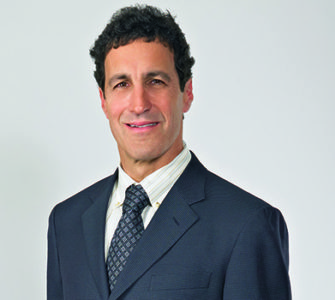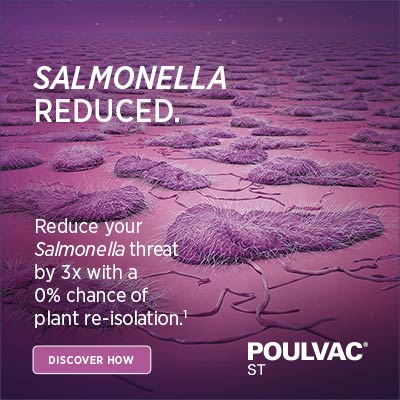Chance of Salmonella vaccine positives at processing ‘zero’ with Poulvac® ST
An interview with Douglas Fulnechek, DVM, senior public health veterinarian, Zoetis
Q: Updated guidelines regarding Salmonella control in raw poultry from USDA’s Food Safety and Inspection Service (FSIS) say that live Salmonella vaccines used during production could introduce a hazard at processing.1 What exactly does FSIS mean?
DF: FSIS is concerned that some live Salmonella vaccines administered to broilers and young turkeys during production will be found at processing. Poultry company processing plants could be adversely affected by vaccines that persist. A persistent vaccine strain counts in the determination of FSIS categories and could push the processing plant into an undesirable category.
Q: Poulvac® ST is a modified-live vaccine. Can it be reisolated at the plant?
DF: It cannot. It has been designed for there to be a 0% chance that Poulvac ST will be isolated by FSIS at processing.2
Q: What proof do you have the vaccine can’t be recovered?
DF: Poulvac ST has never been recovered from an FSIS sample. The vaccine has been used for years at poultry operations throughout the US, and it has not been found in any of our customers’ processing establishments.
In addition, FSIS submits whole-genome sequencing of all isolates to the National Center for Biotechnology Information database; Zoetis scientists have conducted an exhaustive analysis and could find no isolates in the database with any genetic similarity to Poulvac ST.3
Q: Why can’t Poulvac ST be isolated by FSIS at processing?
DF: A gene known as aroA has been deleted from the S. Typhimurium strain in Poulvac ST. Without that gene, the vaccine bacteria cannot continue to replicate. In other words, the vaccine creates a self-limiting, nonpersistent infection. The vaccine can be recovered for up to 2 weeks after vaccination,4,5 but then ceases to persist in the bird, on the bird or in the environment.
Q: If it stops replicating, how does Poulvac ST lower the load of Salmonella going into processing?
DF: Before it stops replicating, the vaccine induces immunity that reduces Salmonella colonization in internal organs and ceca. That, in turn, reduces the load of the pathogen going into the processing plant.
In one of the many trials we’ve conducted with the vaccine, flocks that received Poulvac ST were up to three times less likely to test positive for Salmonella compared to unvaccinated flocks. They also had a higher average daily gain and better adjusted feed conversion.6
Q: There are many different kinds of Salmonella. Can live Salmonella vaccines protect against different serotypes?
DF: They can competitively exclude different serotypes of Salmonella from colonizing the gastrointestinal tract when young poultry are immunologically immature. Studies indicate it’s possible to increase the level of cross-protective immunity with live vaccines if you give a booster dose.7
Q: FSIS also says in its guidelines that poultry establishments are advised to show how their use of Salmonella vaccines does not affect the safety of poultry products derived from vaccinated poultry and does not interfere with FSIS inspection procedures. How can poultry establishments live up to these guidelines?
DF: Zoetis is providing a letter of assurance to customers explaining why Poulvac ST won’t be recovered at processing. The letter supports live-vaccine decisions made in the hazard analysis. We’re also conducting additional whole-genome sequencing analysis; we expect that work will provide additional evidence that Poulvac ST has no similarity to Salmonella isolates recovered by FSIS at processing.
1 FSIS Guidelines for Controlling Salmonella in Raw Poultry. June 2021. https://www.fsis.usda.gov/sites/default/files/media_file/2021-07/FSIS-GD-2021-0005.pdf Accessed December 5, 2021.
2 Data on file, Study Report No. 04-16-7ADMJ, Zoetis LLC.
3 Personal communication, Angela Hartman, PhD, Veterinary Medical Research and Development, Zoetis.
4 Data on file, Study Report TIA 22492, Zoetis LLC.
5 Data on file, Study Report TIA 22485, Zoetis LLC.
6 Data on file, Study Report No. 04-16-7ADMJ, Zoetis LLC.
7 Hofacre C, et al. Immunity and Protection Provided by Live Modified Vaccines Against Paratyphoid Salmonella in Poultry— An Applied Perspective. Avian Dis. 2021;65:295-302.
All trademarks are the property of Zoetis Services LLC or a related company or a licensor unless otherwise noted.
TOOLBOX, Issue 33
Toolbox is a series of interviews with veterinarians and other technical specialists about their experiences managing antimicrobials, vaccines and other tools for poultry health. It is produced by the editors of Poultry Health Today on behalf of the US Poultry Business of Zoetis.
BIO-00345
Feb 2022
Posted on April 19, 2022














